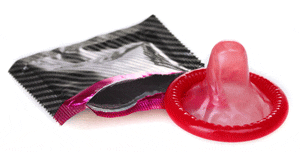Contraception

Once your baby is born, you must consider contraception. It is wise to make some decisions before the baby arrives, so you can be prepared. Despite many myths, breastfeeding does not prevent pregnancy. In fact, some women may get pregnant again before they get a period! Here are some options to consider…
A sexual health website by The Society of Obstetricians and Gynaecologists of Canada. Includes a variety of resources.
Women’s College Hospital Bay Centre for Birth Control Clinic (external link)
The clinic offers comprehensive sexual and reproductive health care for women in Ontario and also sells affordable birth control.
Barrier methods
A low risk method, but failure rates can be high if not used properly and consistently. Failure rates range from 3-12% for condoms and as high as 26% for the sponge. Failure rates are lower when barrier methods are combined with spermicide.

Condoms are the only method of contraception that will protect you from sexually transmitted infections.
Available without a prescription
- Condoms
- Female condoms
Available with a prescription
- Diaphragm (women who have used a diaphragm before should be refitted after pregnancy)
- Cervical cap
Combined hormonal methods
The oral contraceptive pill, vaginal ring and patch are very effective, reversible methods with many non-hormonal benefits. Periods will occur monthly. All three methods work in the same way, with the same risks and side effects. What differs is how the drug reaches the body. Side effects vary from person to person, brand to brand and method to method. These are available by prescription only. Failure (chance of getting pregnant) rates range from 0.1-3%.
Pill — taken every day.
Vaginal ring — inserted by yourself and left in for three weeks and removed for one week before a new one is inserted. Failure rates may be a little lower than the pill.
Patch — applied to the skin and changed weekly for three weeks followed by one week off.
If you are more than six weeks post delivery and you are breast-feeding well, it is safe to take combined hormonal contraception while breast-feeding. If you are struggling to produce enough milk, you might want to try a barrier or progestin-only method.
Side effects
Common, often go away in two to three months
- Bloating
- Breast tenderness
- Headache
A rare, but serious side-effect is a blood clot in the legs, lungs or eye. See a doctor immediately if you have chest pain, shortness or breath or pain and swelling in your legs.
Non-contraceptive benefits
- Cycle regulation
- Decreased menstrual flow
- Increased bone mineral density
- Decreased painful periods
- Decreased acne
- Decreased hair growth on the face
- Decreased endometrial and ovarian cancer
- Possibly fewer ovarian cysts
- Possibly fewer cases of benign breast disease
- Possibly less colon cancer
Progestin-only methods
Micronor — taken daily without a week off at any time. Your periods may be irregular. This is a good option when breast-feeding, as the failure rate is 1-9%.
Depoprovera — this is an injection given every 12 weeks. Periods may be irregular. It has a very low failure rate at 0.3%. There are concerns about loss of bone density (ie. brittle bones) developing after long-term use of Depoprovera. About half of the women who have it will also have no periods at all while they are on this medication. It can take up to one to two years for return of periods once the medications are stopped.
Side effects
- Irregular periods
- Bloating
- Breast tenderness
- Acne
- Headaches
- Half the women who use it have no periods (depoprovera)
- 1-2 years to resume periods (depoprovera)
- Weight gain (depoprovera)
IUD (intrauterine device)
An IUD is a small T-shaped device that is inserted into your uterus by your doctor. It lasts for 3-5 years. It is associated with a small risk of infection, sometimes the IUD can fall out and rarely it can go past the uterine wall while being inserted. Failure rates are extremely low, but if you do get pregnant, there is a chance of an ectopic (tubal) pregnancy.
Copper IUD — has no hormones in it. Is the cheapest type of IUD, but can cause heavier periods with more cramps.
Progestin IUD — progestin IUDs have a very small amount of progestin that is released slowly from the device, making it more effective. It can be associated with spotting for the first three to six months of use, but then after that half the women have no period at all and the other half have a very light period. The Mirena IUD lasts for five years, but there is also a three-year version called Jaydess.
Visit the sexandu.ca website
Benefits
- Don’t have to remember to take something every day
- As effective as surgical sterilization, but totally reversible
- Periods will be lighter and less painful (progestin IUD)
- Periods will usually return in a few months once IUD is removed
Side effects
- Infection
- IUD can fall out
- IUD may perforate (go right through) uterus
- Ectopic pregnancy
- Heavier, crampier periods (copper IUD)
- Spotting (progestin IUD)
- Half of the women will not have a period (Mirena)
Surgical — permanent methods
Tubal Ligation (for her) — a tubal ligation isa permanent method of birth control and should only be considered by those who are absolutely certain that they do not ever want to have another pregnancy. It can be done at the time of a c-section, three months postpartum or later. When it is done at a time other than a C-section, a day surgery procedure is done under general anaesthetic. It is usually done laparoscopically and if all goes well, you can go home the same day. Most surgeons will entirely remove the tubes rather than just clip them, as this is thought to reduce your future risk of ovarian cancer. The risks and side effects are small. While it is permanent, there is still a failure rate of 0.5%. Learn about sterilization on Planned Parenthood (external website)
Essure (for her) — this procedure is still relatively new in Canada and is only done at Women’s College Hospital. A very small camera in inserted into the uterus and a little flexible insert is put into the fallopian tubes to block them. The advantage to this procedure is that you do not need to make any incisions. However, you must wait about three months for the procedure to prevent pregnancy and take a confirmatory test to ensure the fallopian tubes are in fact blocked.
Vasectomy (for him) — another permanent method of birth control with very few side effects and risks (fewer even than a tubal ligation). It is done as a day surgery procedure or in a doctor’s office, and often only a light anesthetic is required. Failure rates are the lowest of any method (0.2%).
An IUD is just as effective as a tubal ligation without all the surgical risks associated with a tubal ligation!
Benefits of a tubal ligation
- Permanent
- No hormones
- No side-effects if everything goes well with surgery
- Don’t have to remember to take something every day
- Very effective (failure rate = 0.5%)
- May reduce your future risk of ovarian cancer if the tubes are removed rather than clipped or burned
Risks of a tubal ligation
- Anaesthesia
- Bleeding
- Infection
- Injury to other structures like the bladder, bowel, nerves, blood vessels
- need for a larger abdominal incision
- Recovery time
- IRREVERSIBLE
- Regret (especially if you are under the age of 30)
- Does not change your bleeding pattern
- Does not protect from sexually transmitted infections
- Risk of ectopic or tubal pregnancy

Contraception while breastfeeding
Breastfeeding will reduce your fertility, but should not be relied upon for effective birth control. Barrier methods and IUDs are good options with no negative effect on breast milk. This includes the progestin and copper IUDs, Micronor and depoprovera.
Combined hormonal contraceptives are safe in breast milk, though the volume of milk produced can be reduced somewhat. However, this is not usually a problem once you have been breastfeeding for six weeks and the milk supply is well established and can be discussed further with your caregiver.
You must not rely on the information on this website as an alternative to medical advice from your doctor or other professional healthcare provider. If you have any specific questions about any medical matter you should consult your healthcare provider. If you think you may be suffering from any medical condition you should seek immediate medical attention. You should never delay seeking medical advice, disregard medical advice, or discontinue medical treatment because of information on this website.
